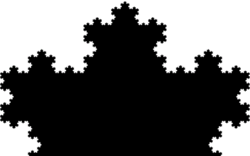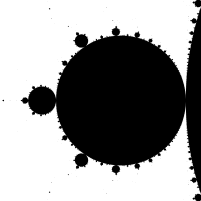

In mathematics, a self-similar object is exactly or approximately similar to a part of itself (i.e., the whole has the same shape as one or more of the parts). Many objects in the real world, such as coastlines, are statistically self-similar: parts of them show the same statistical properties at many scales. Self-similarity is a typical property of fractals. Scale invariance is an exact form of self-similarity where at any magnification there is a smaller piece of the object that is similar to the whole. For instance, a side of the Koch snowflake is both symmetrical and scale-invariant; it can be continually magnified 3x without changing shape. The non-trivial similarity evident in fractals is distinguished by their fine structure, or detail on arbitrarily small scales. As a counterexample, whereas any portion of a straight line may resemble the whole, further detail is not revealed.
A time developing phenomenon is said to exhibit self-similarity if the numerical value of certain observable quantity measured at different times are different but the corresponding dimensionless quantity at given value of remain invariant. It happens if the quantity exhibits dynamic scaling. The idea is just an extension of the idea of similarity of two triangles. Note that two triangles are similar if the numerical values of their sides are different however the corresponding dimensionless quantities, such as their angles, coincide.
Peitgen et al. explain the concept as such:
If parts of a figure are small replicas of the whole, then the figure is called self-similar....A figure is strictly self-similar if the figure can be decomposed into parts which are exact replicas of the whole. Any arbitrary part contains an exact replica of the whole figure.
Since mathematically, a fractal may show self-similarity under indefinite magnification, it is impossible to recreate this physically. Peitgen et al. suggest studying self-similarity using approximations:
In order to give an operational meaning to the property of self-similarity, we are necessarily restricted to dealing with finite approximations of the limit figure. This is done using the method which we will call box self-similarity where measurements are made on finite stages of the figure using grids of various sizes.
This vocabulary was introduced by Benoit Mandelbrot in 1964.
Self-affinity

In mathematics, self-affinity is a feature of a fractal whose pieces are scaled by different amounts in the x- and y-directions. This means that to appreciate the self similarity of these fractal objects, they have to be rescaled using an anisotropic affine transformation.
Definition
A compact topological space X is self-similar if there exists a finite set S indexing a set of non-surjective homeomorphisms for which
If , we call X self-similar if it is the only non-empty subset of Y such that the equation above holds for . We call
a self-similar structure. The homeomorphisms may be iterated, resulting in an iterated function system. The composition of functions creates the algebraic structure of a monoid. When the set S has only two elements, the monoid is known as the dyadic monoid. The dyadic monoid can be visualized as an infinite binary tree; more generally, if the set S has p elements, then the monoid may be represented as a p-adic tree.
The automorphisms of the dyadic monoid is the modular group; the automorphisms can be pictured as hyperbolic rotations of the binary tree.
A more general notion than self-similarity is self-affinity.
Examples


The Mandelbrot set is also self-similar around Misiurewicz points.
Self-similarity has important consequences for the design of computer networks, as typical network traffic has self-similar properties. For example, in teletraffic engineering, packet switched data traffic patterns seem to be statistically self-similar. This property means that simple models using a Poisson distribution are inaccurate, and networks designed without taking self-similarity into account are likely to function in unexpected ways.
Similarly, stock market movements are described as displaying self-affinity, i.e. they appear self-similar when transformed via an appropriate affine transformation for the level of detail being shown. Andrew Lo describes stock market log return self-similarity in econometrics.
Finite subdivision rules are a powerful technique for building self-similar sets, including the Cantor set and the Sierpinski triangle.

In cybernetics
The viable system model of Stafford Beer is an organizational model with an affine self-similar hierarchy, where a given viable system is one element of the System One of a viable system one recursive level higher up, and for whom the elements of its System One are viable systems one recursive level lower down.
In nature

Self-similarity can be found in nature, as well. To the right is a mathematically generated, perfectly self-similar image of a fern, which bears a marked resemblance to natural ferns. Other plants, such as Romanesco broccoli, exhibit strong self-similarity.
In music
- Strict canons display various types and amounts of self-similarity, as do sections of fugues.
- A Shepard tone is self-similar in the frequency or wavelength domains.
- The Danish composer Per Nørgård has made use of a self-similar integer sequence named the 'infinity series' in much of his music.
- In the research field of music information retrieval, self-similarity commonly refers to the fact that music often consists of parts that are repeated in time. In other words, music is self-similar under temporal translation, rather than (or in addition to) under scaling.
See also
- Droste effect
- Golden ratio
- Logarithmic spiral
- Long-range dependency
- Non-well-founded set theory
- Recursion
- Self-dissimilarity
- Self-reference
- Self-replication
- Self-similarity of network data analysis
- Self-similar process
- Teragon
- Tessellation
- Tweedie distributions
- Zipf's law
- Fractal
References
- Mandelbrot, Benoit B. (1982). The Fractal Geometry of Nature, p.44. ISBN 978-0716711865.
- Mandelbrot, Benoit B. (5 May 1967). "How long is the coast of Britain? Statistical self-similarity and fractional dimension". Science. New Series. 156 (3775): 636–638. Bibcode:1967Sci...156..636M. doi:10.1126/science.156.3775.636. PMID 17837158. S2CID 15662830. Archived from the original on 19 October 2021. Retrieved 12 November 2020. PDF
- Hassan M. K., Hassan M. Z., Pavel N. I. (2011). "Dynamic scaling, data-collapseand Self-similarity in Barabasi-Albert networks". J. Phys. A: Math. Theor. 44 (17): 175101. arXiv:1101.4730. Bibcode:2011JPhA...44q5101K. doi:10.1088/1751-8113/44/17/175101. S2CID 15700641.
{{cite journal}}: CS1 maint: multiple names: authors list (link) - Hassan M. K., Hassan M. Z. (2009). "Emergence of fractal behavior in condensation-driven aggregation". Phys. Rev. E. 79 (2): 021406. arXiv:0901.2761. Bibcode:2009PhRvE..79b1406H. doi:10.1103/physreve.79.021406. PMID 19391746. S2CID 26023004.
- Dayeen F. R., Hassan M. K. (2016). "Multi-multifractality, dynamic scaling and neighbourhood statistics in weighted planar stochastic lattice". Chaos, Solitons & Fractals. 91: 228. arXiv:1409.7928. Bibcode:2016CSF....91..228D. doi:10.1016/j.chaos.2016.06.006.
- Peitgen, Heinz-Otto; Jürgens, Hartmut; Saupe, Dietmar; Maletsky, Evan; Perciante, Terry; and Yunker, Lee (1991). Fractals for the Classroom: Strategic Activities Volume One, p.21. Springer-Verlag, New York. ISBN 0-387-97346-X and ISBN 3-540-97346-X.
- Peitgen, et al (1991), p.2-3.
- Comment j'ai découvert les fractales, Interview de Benoit Mandelbrot, La Recherche https://www.larecherche.fr/math%C3%A9matiques-histoire-des-sciences/%C2%AB-comment-jai-d%C3%A9couvert-les-fractales-%C2%BB
- Leland, W.E.; Taqqu, M.S.; et al. (January 1995). "On the self-similar nature of Ethernet traffic (extended version)" (PDF). IEEE/ACM Transactions on Networking. 2 (1): 1–15. doi:10.1109/90.282603. S2CID 6011907.
- Benoit Mandelbrot (February 1999). "How Fractals Can Explain What's Wrong with Wall Street". Scientific American.
- Campbell, Lo and MacKinlay (1991) "Econometrics of Financial Markets ", Princeton University Press! ISBN 978-0691043012
- Foote, Jonathan (30 October 1999). "Visualizing music and audio using self-similarity". Proceedings of the seventh ACM international conference on Multimedia (Part 1) (PDF). pp. 77–80. CiteSeerX 10.1.1.223.194. doi:10.1145/319463.319472. ISBN 978-1581131512. S2CID 3329298. Archived (PDF) from the original on 9 August 2017.
- Pareyon, Gabriel (April 2011). On Musical Self-Similarity: Intersemiosis as Synecdoche and Analogy (PDF). International Semiotics Institute at Imatra; Semiotic Society of Finland. p. 240. ISBN 978-952-5431-32-2. Archived from the original (PDF) on 8 February 2017. Retrieved 30 July 2018. (Also see Google Books)
External links
- "Copperplate Chevrons" — a self-similar fractal zoom movie
- "Self-Similarity" — New articles about Self-Similarity. Waltz Algorithm
Self-affinity
- Mandelbrot, Benoit B. (1985). "Self-affinity and fractal dimension" (PDF). Physica Scripta. 32 (4): 257–260. Bibcode:1985PhyS...32..257M. doi:10.1088/0031-8949/32/4/001. S2CID 250815596.
- Sapozhnikov, Victor; Foufoula-Georgiou, Efi (May 1996). "Self-Affinity in Braided Rivers" (PDF). Water Resources Research. 32 (5): 1429–1439. Bibcode:1996WRR....32.1429S. doi:10.1029/96wr00490. Archived (PDF) from the original on 30 July 2018. Retrieved 30 July 2018.
- Benoît B. Mandelbrot (2002). Gaussian Self-Affinity and Fractals: Globality, the Earth, 1/F Noise, and R/S. Springer. ISBN 978-0387989938.
| Fractals | |
|---|---|
| Characteristics | |
| Iterated function system | |
| Strange attractor | |
| L-system | |
| Escape-time fractals | |
| Rendering techniques | |
| Random fractals | |
| People | |
| Other |
|
 measured at different times are different but the corresponding dimensionless quantity at given value of
measured at different times are different but the corresponding dimensionless quantity at given value of  remain invariant. It happens if the quantity
remain invariant. It happens if the quantity  for which
for which

 , we call X self-similar if it is the only
, we call X self-similar if it is the only 